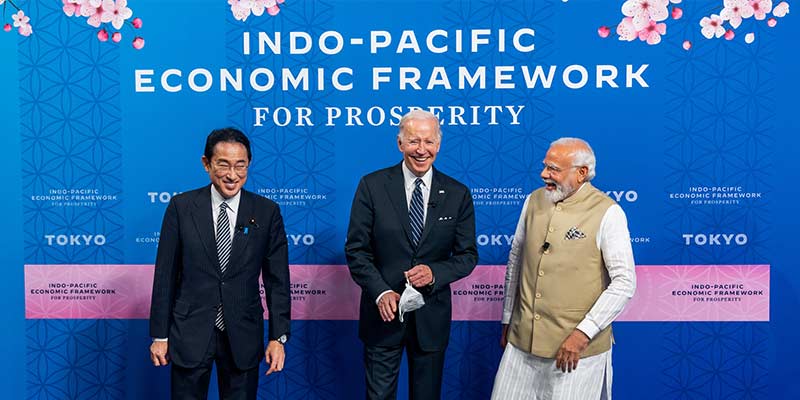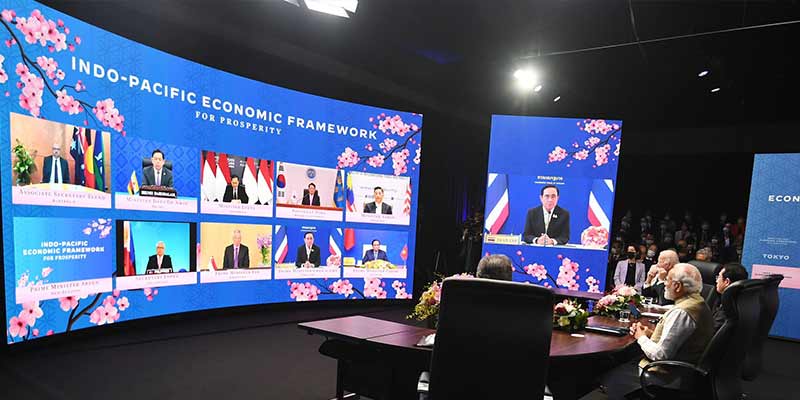- India
- May 24
India joins Indo-Pacific Economic Framework (IPEF)
• India joined a US-led initiative to set up an Indo-Pacific Economic Framework (IPEF).
• Rolling out the IPEF a day ahead of the Quad summit in Tokyo, US President Joe Biden said a dozen partners have joined the new initiative.
• The IPEF seeks to strengthen economic partnership amongst participating countries with the objective of enhancing resilience, sustainability, inclusiveness, economic growth, fairness, and competitiveness in the Indo-Pacific region.
• The IPEF is not a traditional free trade agreement and the fundamental view behind it is that the new landscape and the new challenges need a new approach.
Which countries have joined the IPEF?
• The countries that have joined IPEF are: United States, Australia, Brunei Darussalam, India, Indonesia, Japan, South Korea, Malaysia, New Zealand, Philippines, Singapore, Thailand and Vietnam.
• Together, these countries represent 40 per cent of world GDP.
Highlights of IPEF:
• These countries share a commitment to a free, open, fair, inclusive, interconnected, resilient, secure, and prosperous Indo-Pacific region that has the potential to achieve sustainable and inclusive economic growth.
• As the economic policy interests in the region are intertwined, and deepening economic engagement among partners is crucial for continued growth, peace, and prosperity.
• The pandemic has emphasized the importance of strengthening economic competitiveness and cooperation and securing critical supply chains, while stimulating job growth and improving economic opportunities.
• Through this initiative, the countries aim to contribute to cooperation, stability, prosperity, development, and peace within the region.
Main pillars of the framework:
1) Trade: The partners seek to build high-standard, inclusive, free and fair trade commitments and develop new and creative approaches in trade and technology policy that advance a broad set of objectives that fuels economic activity and investment, promotes sustainable and inclusive economic growth, and benefits workers and consumers. The efforts include, but are not limited to, cooperation in the digital economy.
2) Supply Chains: The countries are committed to improving transparency, diversity, security and sustainability in our supply chains to make them more resilient and well-integrated. It seeks to:
i) Coordinate crisis response measures.
ii) Expand cooperation to better prepare for and mitigate the effects of disruptions to better ensure business continuity.
iii) Improve logistical efficiency and support.
iv) Ensure access to key raw and processed materials, semiconductors, critical minerals, and clean energy technology.
3) Clean Energy, Decarbonisation and Infrastructure: In line with the Paris Agreement goals and efforts to support the livelihood of peoples and workers, the countries plan to accelerate the development and deployment of clean energy technologies to decarbonise economies and build resilience to climate impacts. This involves deepening cooperation on technologies, on mobilising finance, including concessional finance, and on seeking ways to improve competitiveness and enhance connectivity by supporting the development of sustainable and durable infrastructure and by providing technical assistance.
4) Tax and Anti-Corruption: The countries are committed to promoting fair competition by enacting and enforcing effective and robust tax, anti-money laundering, and anti-bribery regimes in line with existing multilateral obligations, standards, and agreements to curb tax evasion and corruption in the Indo-Pacific region. This involves sharing expertise and seeking ways to support capacity building necessary to advance accountable and transparent systems.
Why IPEF is important to the US?
• The rollout of the IPEF came as part of Washington’s efforts to push forward a strong economic policy for the Indo-Pacific to counter China’s aggressive strategy on trade in the region.
• The US is an Indo-Pacific economic power and expanding the country’s economic leadership in the region is good for American workers and businesses.
• IPEF will enable the US and its allies to decide on rules of the road that ensure American workers, small businesses, and ranchers can compete in the Indo-Pacific.
• This framework will help lower costs by making the supply chains more resilient in the long term, protecting the country against costly disruptions that lead to higher prices for consumers.
• US foreign direct investment in the region totaled more than $969 billion in 2020 and has nearly doubled in the last decade.
• The US is the leading exporter of services to the region. Trade with the Indo-Pacific supports more than three million American jobs and is the source of nearly $900 billion in foreign direct investment in the US.
• With 60 per cent of the world’s population, the Indo‑Pacific is projected to be the largest contributor to global growth over the next 30 years.
What is India’s stand on IPEF?
• PM Modi said the announcement of IPEF is a declaration of a collective desire to make the Indo-Pacific region an engine of global economic growth.
• India has historically been at the centre of trade flows in the Indo-Pacific region.
• PM Modi called for finding common and creative solutions to tackle economic challenges of the Indo-Pacific region.
• He expressed India’s commitment towards working with all Indo-Pacific countries for an IPEF which is both inclusive and flexible.
• India is committed to a free, open, and inclusive Indo-Pacific region and believes that deepening economic engagement among partners is crucial for continued growth, peace, and prosperity.
• India is keen to collaborate with partner countries under the IPEF and work towards advancing regional economic connectivity, integration and boosting trade and investment within the region.
Manorama Yearbook app is now available on Google Play Store and iOS App Store


